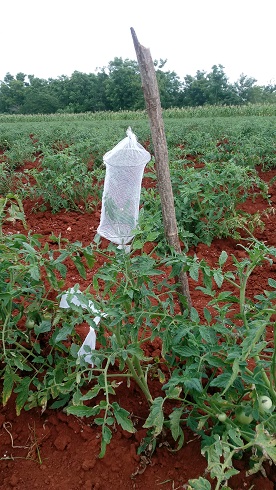Tomato (Solanum lycopersicum) specialized pollination is isolated from neighboring plants and pollinators
DOI:
https://doi.org/10.26786/1920-7603(2022)656Keywords:
buzz, Cuba, Exomalopsis pulchella, pollination networkAbstract
Tomato is one of the crops that require buzz pollination, for which a pollinator vibrates the tubular anthers for pollen to be released. This process is efficiently carried out by wild bees, whose distribution varies according to the geographical location and the particular characteristics of the different agroecosystems. The pollination network associated with tomato fields located in an agricultural area of Cuba was determined by field observations. In addition, it was studied whether pollination influences tomato yield, through exclusion experiments and comparing the characteristics of the fruits obtained in the presence or absence of pollinators. The pollination network consisted of 241 interactions between 12 plants, including tomato, adjacent crops such as papaya and pumpkin, and ruderal species, and 11 floral visitors, fundamentally bees, with 5 species involved. Tomato flowers were almost exclusively visited by the bee species Exomalopsis pulchella, capable of buzz pollination. Species of the genus Exomalopsis are frequent pollinators of tomato in the Neotropic. This denotes a temporary specialization in the use of tomato´s floral resources by Exomalopsis pulchella. Apis mellifera was not detected visiting tomato flowers, despite being present in the pollination network associated with the studied agroecosystem. Pollination significantly increased the dimensions of tomato fruits. Exomalopsis pulchella also visited the ruderal plants Asteraceae sp., Commelinaceae sp. and Milleria quinqueflora. This should be taken into account in the management of the ruderal plant communities that surround the tomato fields, in order to promote and guarantee the presence of the main pollinator of this crop.

Downloads
Published
How to Cite
Issue
Section
License
Copyright (c) 2022 Rijo Gabriela, Alameda Diego, Barro Alejandro

This work is licensed under a Creative Commons Attribution 4.0 International License.
JPE is an open access journal which means that all content is freely available without charge to the user or his/her institution.
Authors who publish with this journal agree to the following terms:
1) Authors retain copyright and grant the journal right of first publication with the work simultaneously licensed under a Creative Commons Attribution License that allows others to share the work with an acknowledgement of the work's authorship and initial publication in this journal.
2) Authors are able to enter into separate, additional contractual arrangements for the non-exclusive distribution of the journal's published version of the work (e.g., post it to an institutional repository or publish it in a book), with an acknowledgement of its initial publication in this journal.
3) Authors are permitted and encouraged to post their work online (e.g., in institutional repositories or on their website) prior to and during the submission process, as it can lead to productive exchanges, as well as earlier and greater citation of published work (See The Effect of Open Access).
To assure a broader targeted audience, content will be included into databases (such as EBSCO) and directories (such as DOAJ).











